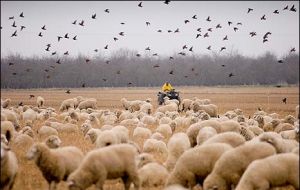MercoPress. South Atlantic News Agency
Chile can become a major player in the global lamb and wool markets

Chile, more precisely the Magallanes region in the extreme south of the country, could play a major role in the global lamb and wool markets? Yes says Jose Marin a Magallanes sheep farmer who has a flock of 135.000, mostly Merino, Corriedale and Meat Merino and thirty years experience and innovation in the industry, reports El Mercurio.
Originally an electric engineer, he has been in sheep farming since the seventies with a clear objective: added value, turning wool and lamb into items with increased quality and weight, helping to the overall appreciation of the sheep farming industry.
His current goal: 18.000 hectares of improved pastures to better feed his flock and thus obtain better quality and weight yields from wool and lamb. “If we keep along this line of innovation and given current circumstances of major competitors, Chile can become a main player in the world market”, says Marin whom El Mercurio describes as the Magallanes “revolutionary” farmer.
In the seventies when land in Magallanes was cheap and sheep farming dwindling, his family invested a million US dollars in farms. “Farmers were selling their land because lamb and wool prices were rock bottom; lamb and mutton were cheaper than chicken” recalls Marin.
He reacted by setting up a butcher shop in Punta Arenas selling lamb and mutton directly to the public. Soon prices begun to climb, even when he had to pay local slaughter houses high fees for the service and was always at the end of the queue.
The following step was to set up his own abattoir, which now-a-days has been completely refurbished and updated at a cost of 12 million US dollars but certified to export to the European Union, Japan, Peru and Panama plus a prize from the Food Engineers association of New Zealand for its innovative engineering.
In 1982 he turned his attention to wool, and was surprised to find out that Uruguayan wool of similar quality, received premium prices. He travelled to Uruguay and in 1988 to New Zealand where he managed to have his wool bails included in the NZ auctions.
“It was fun; my wool obtained some of the highest prices, 3.80 US dollars a kilo, which was historic. However New Zealanders were fearful because Chile had already become a formidable competitor in the kiwi business so we were soon ousted from the wool auction system”, says Marin.
Currently his Sociedad Comercial Jose Marin and Co. Ltd has an annual clip of half a million kilos, 19 microns, which comes mostly from a flock of Australian merino, with a double purpose. “Our target was finer wool, but also meat” says Marin who added that in the last season his wool sold at 4.60 US dollars per kilo, a Magallanes record, when normally Corriedales don’t make more than 2 US dollars a kilo.
He also worked in improving lamb quality by introducing the New Zealand White Safor which he crossed with some of his ewes.
More specifically about the current situation and depressed commodities prices Marin’s policy has been not to sell and retain the clip. “The last season prices plummeted 40%, but now they seem to be recovering and are half way up the ladder. We won’t reach the 4.56 US dollar record but we can be close to 4 dollars” he says with optimism.
Regarding lamb which was costing 3.5 US dollars a kilo last year and now is in the range of 2 US dollars, Marin is also cautious. He includes two variables: the US dollar, which was costing 450 Chilean pesos last year and now, is in the range of 600 pesos, “which make losses even greater”. However domestic demand has remained strong helping to compensate the fall in exports, limited because of lack of financing.
Although supportive of Chile’s open economy, export oriented economy policy, Mr. Marin is critical on the costs and fees charged by Chilean government services and which are specific for the farming sector, “this does not happen with our regional competitors, Uruguay and Argentina: They don’t add costs to production”.
He also suggests that the Chilean Agriculture and Livestock Services, SAG, should have specific lab-offices with specialized technicians in the different meats, and particularly in Magallanes region for mutton and lamb. “SAG has become jack of all trades but master of none”, he points out.
Looking into the future Marin is most optimistic about sheep farming in Chile because of the growing long term world demand and the fact that leading countries such as Australia and Argentina have drastically reduced their flocks by millions.
“This gives room for Chile to become a leading player in the ovine world market. Furthermore at domestic level there’s ample space to increase demand: lamb consumption in Chile is only half a kilo per year, but has increased 30% in the last ten years”, underlines Marin.
Finally he points out that climate change could be positive for Magallanes livestock, since higher temperatures should help better development of improved pastures and food for livestock.
“It rains in spring and we have summers of 25 degrees with more pastures to feed animals. The setback is that we also have more wildlife such as hares and guanacos, which compete with sheep and which nobody is culling”.
Chile’s flock is 4 million head, with the greatest percentage in Magallanes region where an estimated 35 million US dollars have been invested in the last decade in new abattoirs or upgrading those already established.




Top Comments
Disclaimer & comment rulesCommenting for this story is now closed.
If you have a Facebook account, become a fan and comment on our Facebook Page!